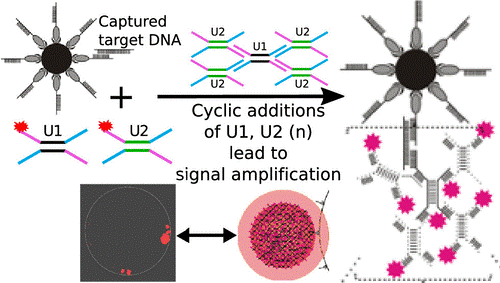


New Achievements of Nano Biomedical Research Centre, School of Biomedical Engineering: Establishment of a clinical detection system based on enzyme-free nucleic acid hybridization chain reaction
July 09, 2019

Recently, Gaolian Xu, assistant researcher of School of Biomedical Engineering, Shanghai Jiao Tong University, published a new article "Cycling of Rational Hybridization Chain Reaction To Enzyme-Free DNA-based Clinical Practice" Diagnosis "on ACS Nano (IF=13.709), which is another innovative breakthrough in the field of microspheres molecular diagnostics, following papers published in Chemical Communications, Advanced Functional Materials, Chemistry of Materials and other journals.

In order to combat the growing threat of global infectious diseases, there is a need for rapid diagnostic technologies that are sensitive and that can provide species specific information (as might be needed to direct therapy as resistant strains of microbes emerge). Here, we present a convenient, enzyme-free amplification mechanism for a rational hybridization chain reaction, which is implemented in a simple format for isothermal amplification and sensing, applied to the DNA-based diagnosis of hepatitis B virus (HBV) in 54 patients. During the cycled amplification process, DNA monomers self-assemble in an organized and controllable way only when a specific target HBV sequence is present. This mechanism is confirmed using super-resolution stochastic optical reconstruction microscopy. The enabled format is designed in a manner analogous to an enzyme-linked immunosorbent assay, generating colored products with distinct tonality and with a limit of detection of ca. five copies/reaction. This routine assay also showed excellent sensitivity (>97%) in clinical samples demonstrating the potential of this convenient, low cost, enzyme-free method for use in low resource settings.
With the rapid development of society and the increasing frequency of people and logistics, new diseases (especially new infectious diseases) emerge in an endless stream, so it is particularly urgent to establish effective and practical disease detection methods with high sensitivity and specificity. Nucleic acid detection is considered to be the most effective clinical detection technique and method due to its high sensitivity and high specificity. However, the current nucleic acid detection methods have relatively high requirements for equipment and material transportation conditions, and cannot be effectively applied to primary hospitals. Based on this, this paper innovatively proposes a clinical detection system based on nucleic acid hybridization chain reaction, which can be combined with enzyme-linked immunoassay to effectively detect pathogens. The detection system first constructs two DNA double-strand hybrid units (U1 and U2) with a dumbbell-shaped structure. Each unit (U1 or U2) can be combined with another unit in a ratio of 1:4, so it can achieve The purpose of amplifying the signal of the target molecule.
Dr. Gaolian Xu, the first author of this paper, is a young scholar of the School of Biomedical and Engineering, who returned from UK in 2017. Now, as an important member of Nano Biomedical Research team led by Professor Hongchen Gu and Professor Hong Xu, several efforts have been made to make faster and better diagnose of low concentration protein and nucleic detection based on magnetic beads. The work of this paper is the result of a collaboration between Dr. Gaolian Xu and Professor Jonathan M. Cooper, University of Glasgow, UK, with the support of EPSRC (EP/I017887/1 and EP/K027611/1) and ERC 340117.
Article link: https://pubs.acs.org/doi/10.1021/acsnano.8b03183